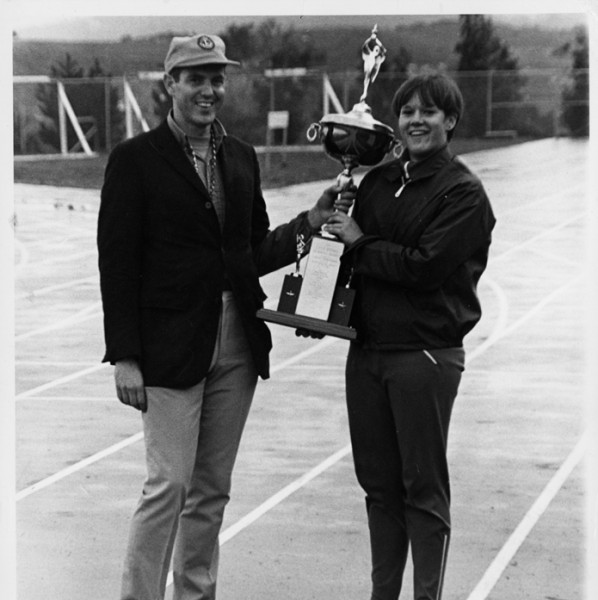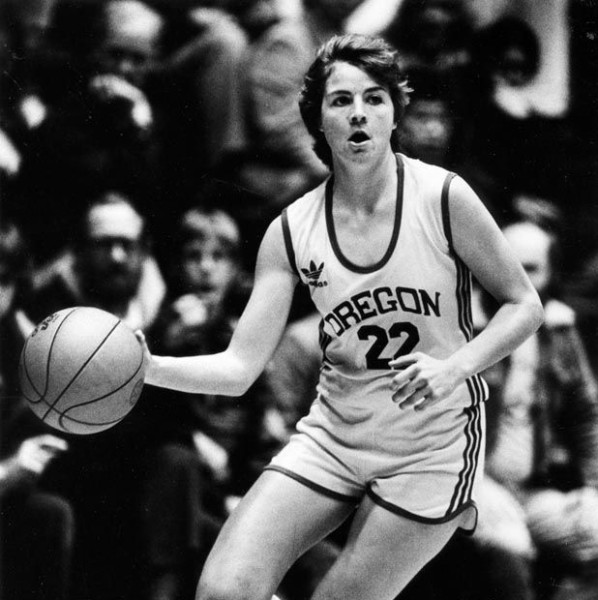Transitioning toward Equality
 From the beginning, Oregon strategically structured women’s athletics to emphasize education, while the men’s program focused more on competition. As a result of this philosophy, women’s sports received substantially less funding. Until the men and women’s programs merged in 1977, financial support for the women came primarily from student fee allocations via the student government.
From the beginning, Oregon strategically structured women’s athletics to emphasize education, while the men’s program focused more on competition. As a result of this philosophy, women’s sports received substantially less funding. Until the men and women’s programs merged in 1977, financial support for the women came primarily from student fee allocations via the student government.
Becky Sisley was the driving force that brought Oregon closer to Title IX compliance standards in the early years. Official mandates from the legislature were not announced until June 1974 and schools had until 1978 to comply. However, Sisley spearheaded many equality efforts in advance of the compliance date. Her countless contributions include helping to form a Women’s Intercollegiate Athletic Advisory Council, creating a Women’s Sports Information Director position, and constructing a women’s locker room and training room. During January 1973, Oregon President Robert Clark created the Women’s Intercollegiate Association (WIA) for interest groups and clubs that competed against other schools. The WIA operated separately from the Women’s Recreation Association (WRA). The WIA became a new unit within the Physical Education Department and Sisley was named director.
As a leader on the 1975-1976 Title IX Task Force to assess the situation at Oregon, Sisley advocated for change in the current athletic landscape. The review uncovered extensive inequalities between the women’s and men’s program, particularly related to funding and support staff services (i.e. sports information, publicity, and administration). As a quick remedy for the shortcomings, the University merged the men and women’s programs on April 1, 1977. As director of the women’s program Sisley advocated for rapid improvements in opportunities for female athletes, and by the fall of 1977 Oregon offered the first athletic scholarships for women.
 National Adjustments
National Adjustments
As the University gradually restructured its athletic offerings, the national scene underwent several changes as well. During January 1979, a national debate between the Association for Intercollegiate Athletics for Women (AIAW) and the National Collegiate Athletic Association (NCAA) emerged. Two years later, the AIAW ceased operations and most member institutions, including Oregon, joined the NCAA in women’s sports.
Continuing the Chapters of Title IX
Since the establishment of Title IX in 1972, Oregon continues to make adjustments to its athletic program. This includes the addition of new sports teams and increased funding for all women’s teams.
A 2002 study revealed that although 54 percent of the University’s students were females, only 37.5 percent of the student-athletes were females. By 2005, the University claimed it was in compliance by meeting one of Title IX’s three benchmarks-continued evidence of improvement.
Road Bumps
The progress made as a result of Title IX has not proceeded without a few hurdles. In the mid-1990s, Jody Runge, University of Oregon’s head women’s basketball coach at the time, filed a suit contending that she was underpaid compared to Ernie Kent, U of O’s head men’s basketball coach. Eventually, Runge’s salary was increased, but not to the level of Kent’s as the University argued that Kent had additional responsibilities that justified a higher salary.
Fun Facts
- The University of Washington was the most aggressive of the Pac-10 schools with Title IX compliance, primarily because it relies on substantial federal grants for its medical center. According to Sisley, the University of Oregon was close behind Washington's efforts.
- Title IX Compliance requires institutions, which receive federal funds, to meet one of the three following criteria: 1. The athletic offerings for women are proportional to the female enrollment in the institution. Only "substantial proportionality" is required. 2. The institution demonstrates a history and continuing practice of expanding sports opportunities for women. 3. The institution shows that the interests and athletic ambitions of women are fully met.